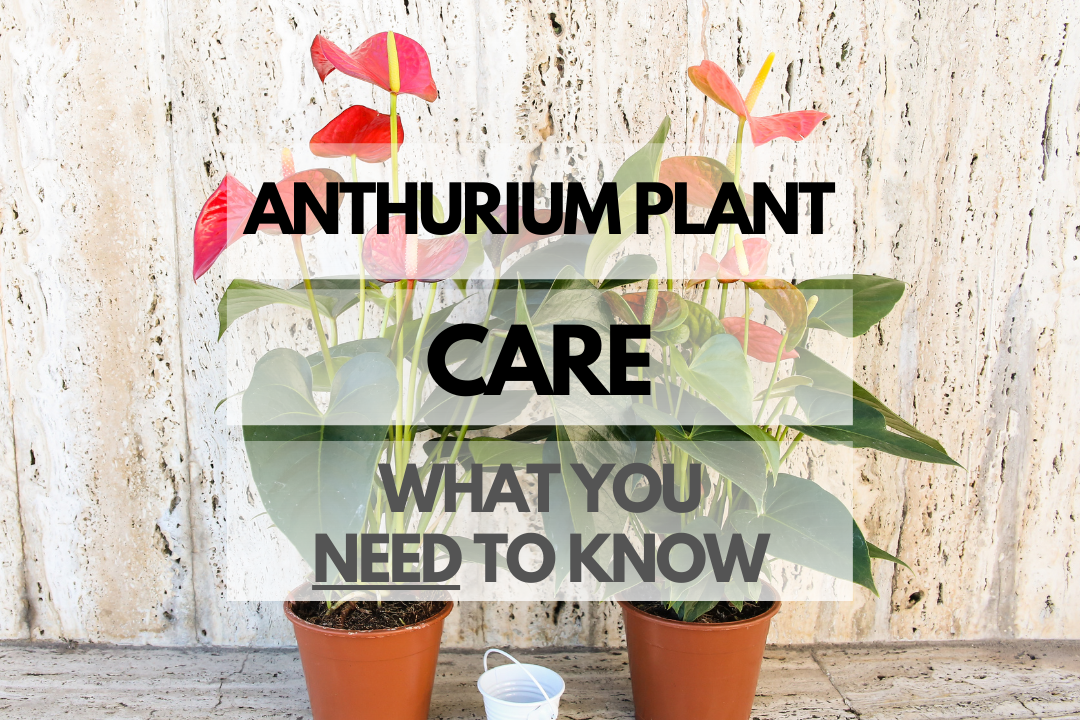Welcome to the world of Anthurium plants! These striking, vibrant plants are a perfect addition to any indoor space, bringing a pop of color and a touch of the tropics. In this care guide, we’ll cover everything you need to know to keep your Anthurium thriving. Let’s dive in!
Anthurium Plant Care Guide
Quick Reference Table: Caring for Anthurium Plant
| Aspect | Details |
|---|---|
| Light | Bright, indirect sunlight |
| Soil | Well-draining, peat moss-based mix |
| Water | Keep soil consistently moist, but not soggy |
| Temperature | 65-80°F (18-27°C) |
| Humidity | High, 60-80% |
| Fertilizer | Monthly, balanced liquid fertilizer diluted to half strength |
| Pruning | Remove yellowing leaves and spent blooms |
Anthurium Plant Sunlight: Do They Need It and How Much?
Anthurium plants thrive in bright, indirect sunlight. Direct sunlight can scorch their leaves, so it’s best to provide filtered light, such as through a sheer curtain. If you notice the leaves turning yellow or becoming pale, this could be a sign that your Anthurium is receiving too much light. On the other hand, if the plant is not producing flowers or has weak, leggy growth, it may not be getting enough light.
Anthurium Plant Soil Tips
The ideal soil for Anthurium plants should be well-draining, lightweight, and rich in organic matter. A mix of peat moss, perlite or orchid bark, and charcoal is a good option. The peat moss retains moisture while the perlite and charcoal improve drainage and aeration, providing the perfect balance for your Anthurium’s roots.
Anthurium Plant Watering and Frequency
Anthurium plants prefer consistently moist soil but do not tolerate soggy conditions. It’s essential to let the top inch of soil dry out between waterings to avoid overwatering and root rot. Generally, watering once a week should suffice. However, you may need to adjust the frequency based on your specific environment and the season, as indoor heating and air conditioning can affect humidity levels.
Pruning Anthurium Plant Properly
Regular pruning helps maintain your Anthurium plant’s appearance and overall health. Remove yellowing leaves and spent blooms by cutting them off at the base with clean, sharp scissors or pruning shears. This will encourage new growth and prevent the plant from wasting energy on dying parts.
Optimal Anthurium Plant Temperature: Can They Tolerate the Cold?
Anthurium plants are tropical plants that prefer temperatures between 65-80°F (18-27°C). They do not tolerate cold drafts or temperatures below 55°F (13°C). If you live in a colder climate, it’s essential to keep your Anthurium plant indoors during the winter months and away from drafty windows or doors.
Common Anthurium Plant Problems
Yellow leaves
Yellow leaves can be a sign of overwatering, underwatering, or excessive sunlight. Check the soil’s moisture level, adjust your watering schedule as needed, and ensure your plant is receiving the right amount of light.
Brown tips on leaves
Brown leaf tips are often a result of low humidity or inconsistent watering. Increase humidity around your plant by misting it regularly, placing it on a tray of pebbles and water, or using a humidifier. Be sure to maintain a consistent watering schedule.
Root rot
Root rot is caused by overwatering and poor drainage. Make sure to use well-draining soil and a pot with drainage holes. Allow the top inch of soil to dry out between waterings to prevent this issue.
<h4″>Lack of bloomsIf your Anthurium plant isn’t producing flowers, it could be due to insufficient light, improper feeding, or a lack of humidity. Ensure your plant receives bright, indirect sunlight, feed it with a balanced liquid fertilizer monthly, and maintain high humidity levels.
Anthurium Plant Outdoors vs Indoors
Anthurium plants can be grown both indoors and outdoors, depending on your climate. However, they are most commonly grown as houseplants due to their sensitivity to cold temperatures.
| Location | Pros | Cons |
|---|---|---|
| Indoors |
|
|
| Outdoors |
|
|
Best Pots for Anthurium Plant
When choosing a pot for your Anthurium plant, consider the following factors:
- Drainage: Ensure the pot has drainage holes to prevent waterlogging and root rot.
- Material: Terra cotta pots are a great option because they are porous and help regulate soil moisture. However, plastic pots can also work if they have good drainage.
- Size: Choose a pot that’s slightly larger than the root ball, allowing for some growth. A pot that’s too large will retain excess moisture and could lead to root rot.
Anthurium Plant Facts
Native to the tropical rainforests of Central and South America, Anthurium plants are known for their stunning, heart-shaped leaves and vibrant, exotic flowers. These evergreen perennials are part of the Araceae family and make beautiful houseplants that can add a touch of the tropics to any indoor space.
Anthurium Plant Benefits
- Air purifier: Anthurium plants are known for their ability to remove harmful toxins from the air, such as formaldehyde, ammonia, and xylene. This can contribute to a healthier indoor environment.
- Low maintenance: These plants are relatively easy to care for, making them a great choice for both experienced plant enthusiasts and beginners alike.
- Long-lasting blooms: Anthurium flowers can last for several weeks, providing a pop of color to your home for an extended period of time.
Growth Rates: How Fast Do They Grow?
Anthurium plants typically grow at a moderate pace, with most species reaching their mature size within a few years. The growth rate may vary depending on factors such as light, temperature, and humidity, but generally, you can expect your Anthurium to grow about 1-2 inches per month.
Anthurium Plant Lifespan
With proper care, Anthurium plants can live for several years, often reaching ages of 5 to 10 years or even longer. To ensure a long and healthy life, provide your Anthurium with the proper light, water, and humidity conditions it needs to thrive.
Are Anthurium Plants Safe?
Anthurium plants contain calcium oxalate crystals, which can cause irritation and swelling if ingested or if they come into contact with the skin. It’s important to keep Anthurium plants out of reach of children and pets to avoid any potential issues.
Anthurium Flowers
Anthurium flowers, also known as spathes, are large, colorful, and waxy. They come in a variety of colors, including red, pink, white, and green. The actual flowers are tiny and found on a spike in the center of the spathe, called the spadix. Anthurium flowers can last for weeks, making them a long-lasting and attractive addition to your home decor.
Anthurium Types and Varieties
Anthurium andraeanum
This is the most common type of Anthurium, featuring large, heart-shaped leaves and bright red spathes. It’s often called the Flamingo Flower or Painter’s Palette and is a popular choice for indoor houseplants.
Anthurium scherzerianum
Also known as the Pigtail Anthurium or Flamingo Lily, this variety has more elongated, lance-shaped leaves and a curled spadix. It produces spathes in shades of red, orange, and pink.
Anthurium veitchii
Commonly called the King Anthurium, this impressive plant has large, rippled leaves that can grow up to 6 feet long. Its flowers are typically green and white, with a long, tapered spadix.
Anthurium Plant Pros and Cons
| Pros | Cons |
|---|---|
| Air purifying | Potentially toxic to children and pets |
| Low maintenance | Requires high humidity |
| Long-lasting blooms | Can be susceptible to pests and diseases |
Anthurium Plant Cost
The cost of an Anthurium plant can vary depending on factors such as size, age, and variety. Generally, you can expect to pay anywhere from $10 to $50 or more for an Anthurium plant.
Where to Buy Anthurium Plants
Anthurium plants can be purchased at local nurseries, garden centers, and online retailers. Some popular online sources for Anthurium plants include Etsy, Amazon, and specialized plant shops.
Is Anthurium Plant Propagation in Water Possible?
Yes, Anthurium plant propagation in water is possible and relatively easyto do. Simply take a stem cutting with at least one or two healthy leaves and place it in a jar or vase filled with water. Make sure to change the water regularly to prevent bacterial growth. In a few weeks, you should see new roots forming, after which you can transfer the cutting to soil.
Additional Resources
FAQ for Anthurium Plant Care
Are Anthurium plants toxic to cats?
Yes, Anthurium plants are toxic to cats due to the calcium oxalate crystals they contain. Ingestion can cause irritation, drooling, vomiting, and difficulty swallowing.
Are Anthurium plants toxic to dogs?
Yes, Anthurium plants are also toxic to dogs and can cause similar symptoms as in cats, including irritation, drooling, vomiting, and difficulty swallowing.
Are Anthurium plants toxic to kids?
Anthurium plants can be toxic to kids if ingested or if the calcium oxalate crystals come into contact with their skin. It’s best to keep these plants out of reach of children to avoid any potential issues.
How tall do Anthurium plants get?
Depending on the variety, Anthurium plants can range in height from 1 to 6 feet. Most commonly grown houseplant varieties reach a height of 1 to 2 feet.
Can Anthurium plants live outside?
Anthurium plants can be grown outside in tropical and subtropical climates where temperatures remain consistently warm and frost-free. In cooler climates, they should be grown indoors or brought inside during the colder months.
Are Anthurium plants poisonous?
Anthurium plants are considered poisonous due to the calcium oxalate crystals they contain, which can cause irritation and swelling if ingested or if they come into contact with the skin. Keep these plants away from children and pets to prevent any potential issues.
</h4″>

